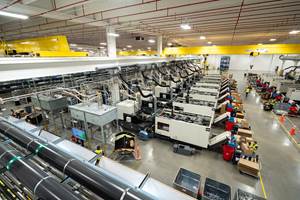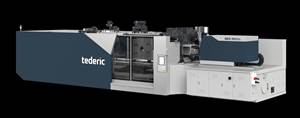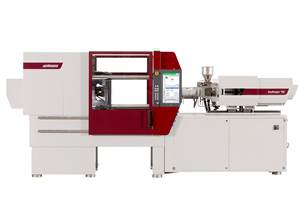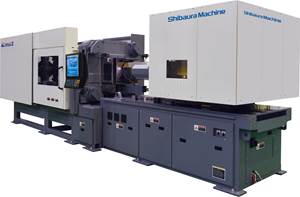For Repeatable Molding, Add Some Variability
Engel finds repeatability in a variable process.
The contrast in the two images couldn’t be more stark. On the left, bars marking screw position run jagged, lengthening and shortening the whole way down. On the right, a perfectly straight line can be drawn down the corresponding short shots molded from those varied screw positions.
Joachim Kragl, director of advanced injection molding systems at injection molding and automation supplier Engel, explained the dichotomy between the images at Engel’s recent symposium at its Corona, Calif. technical center, but first he had a question for his audience.
“It’s 2015; all-electric injection molding machines offer precision, but we still get short shots, we still get flash—why?” Kragl asked.
Why indeed; if servo motors can ensure screws travel the virtually same path on every shot, down to the micron, how are different amounts of material injected into the mold?
To answer the question, Engel took an all-electric press and measured the repeatability of its stroke. It found variations of ± 3 µm on stop and ± 10 µm in start positions, which would theoretically result in a variation of .009g in part weight. In reality, however, the shot-to-shot weight variation ranged up to .011g.
Potential culprits are numerous—slippage of check ring on the machine side—with variations in material viscosity playing a role. Those viscosity changes could derive from multiple factors, ranging from inadequate material drying to the presence of regrind to lot-to-lot inconsistencies in resin.
Accepting some variation as an inevitability, Engel sought the best outcome by treating the symptoms of the malady, namely short shots and flash. The answer has been its iQ weight control software, which tracks the changes as they occur and varies the screw position in real time to get the closest to the desired shot volume. (You can read more about the software here).
In practice, the software looks at injection pressure vs. screw stroke, taking a reference pressure curve and splitting it into three areas:
- Volume variation (as the check ring closes)
- Changes in viscosity
- Conformance of pressure profile
The result: molders have been able to reduce shot weight variation by up to 85%, according to Engel, with the biggest potential improvements coming in thin-wall parts. “We tackle the viscosity as well as the volume variation,” Kragl explained after his presentation, noting that dealing with both variables heightens iQ’s effectiveness and is possible because the machine maker can “grab data directly in the machine.”
‘No flipping way!’
Nearly three years since its launch, the technology has seen increasing adoption, according to Kragl, albeit more so in Europe than North America. The fact that it creates a repeatable process by varying that process shot to shot has met some resistance, however.
“If you tell someone your cutover point will not be constant and you don’t want it to be constant, they’d just be shocked because that’s what they point the process toward,” Kragl explained. “It’s got to be a repeatable process and position. We say, ‘You know what? Forget that. In order to make your part consistent, this will move,’ and that scares a lot of people.”
In particular, it scares quality folks in industries like automotive and medical, where meticulous documentation of set-in-stone processes is mandatory. “In most of these discussions, first with the processing guys, they’re like, ‘That’s pretty cool and then next we talk to the quality manager, and they’re like, ‘Hey, no flipping way!’” Kragl said with a laugh. “Part of it is actually finding means to kind of make them feel comfortable, let them know if [the process] changes you get a higher quality part.”
One molder, one shot at a time, it seems Kragl and Engel are winning converts.

Related Content
IPEX Opens Injection Molding Facility in North Carolina
The pipe and fittings manufacturer’s new 200,000-square-foot facility represents a $200 million investment and will create 150 jobs.
Read MoreTederic Promotes High Technology, Broader Market Presence
Four cells are running in its booth including a 1,300-ton multimaterial system highlighting its 2K capabilities.
Read MoreFakuma 2023: Wittmann Battenfeld Expands All-Electric Line, Direct-Current Capabilities
Wittmann Battenfeld will introduce the new EcoPower B8X injection molding machine line and show direct current as an energy source for a concept machine that will power its own robot.
Read MoreCompletely Connected Molding
NPE2024: Medical, inmold labeling, core-back molding and Industry 4.0 technologies on display at Shibaura’s booth.
Read MoreRead Next
Beyond Prototypes: 8 Ways the Plastics Industry Is Using 3D Printing
Plastics processors are finding applications for 3D printing around the plant and across the supply chain. Here are 8 examples to look for at NPE2024.
Read MoreMaking the Circular Economy a Reality
Driven by brand owner demands and new worldwide legislation, the entire supply chain is working toward the shift to circularity, with some evidence the circular economy has already begun.
Read MoreLead the Conversation, Change the Conversation
Coverage of single-use plastics can be both misleading and demoralizing. Here are 10 tips for changing the perception of the plastics industry at your company and in your community.
Read More


























